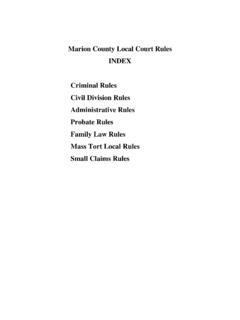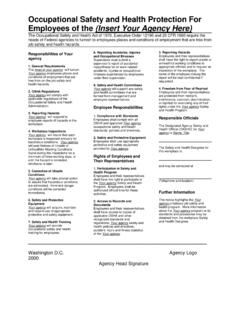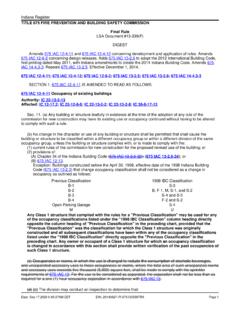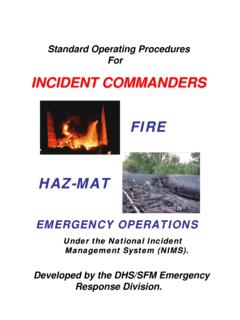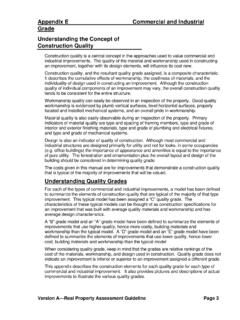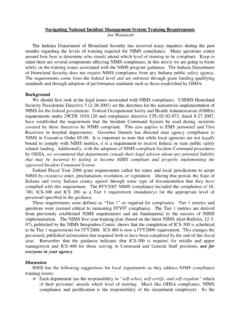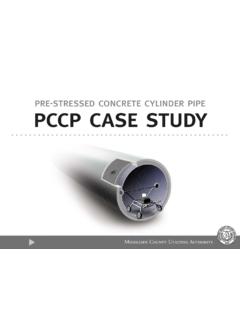Transcription of PORTLAND CEMENT CONCRETE PAVEMENT, PCCP - in.gov
1 GIFE PORTLAND CEMENT CONCRETE PAVEMENT, PCCP Rev. 05-18-20 8-1 SECTION 8 PORTLAND CEMENT CONCRETE PAVEMENT, PCCP INTRODUCTION (Rev. 04-30-09) INDOT has specifications for both QC/QA PCCP (Section 501) and non-QC/QA PCCP (Section 502). The specifications for QC/QA PCCP require a QCP in accordance with ITM 803. The major differences between the two specifications are the testing and documentation requirements. The planned quantity of CONCRETE pavement will determine whether the pay items are 501 or 502. There must be at least 7,200 syd of a CONCRETE pavement item for section 501 to be applied.
2 If a contract starts as a section 502 pavement, but a significant increase in the quantity is authorized, then the DMTE should be contacted to determine if the pavement should be tested under section 501. The contractor is responsible for designing the CONCRETE mixes in accordance with the specifications. All mix designs are reviewed for compliance with specifications. Section 501 mixes also require a trial batch procedure. These instructions apply to both 501 and 502 CONCRETE pavements unless specifically indicated otherwise. PERSONNEL AND EQUIPMENT (Rev. 05-18-20) When CONCRETE mix is to be provided from a captive plant and the contractor has the mixer and the aggregate batchers ready for operation, notify the DMTE to arrange for inspection and testing of the water meter on the mixer and the scales on the batchers.
3 The checking of all other equipment and tools is to be done by the project personnel. Give particular attention to the finishing machine screed crown, the screed and float pan crown of the finisher-float, if used, or the crown, in the rails of the mechanical longitudinal float, and the subgrade scratch template. Equipment for making plastic CONCRETE tests should be obtained through the DMTE before paving operations are started and must be properly calibrated prior to use as outlined in Section 45 of these instructions. Prior to a trail batch demonstration, a discussion should be held with the CCT on the operation to ensure they understand their responsibilities and documentation requirements.
4 Prior to the start of the paving, a pre-paving meeting should be held with the contractor and all INDOT personnel who will be inspecting the paving operations to outline everyone s responsibilities and review the paving plan and schedule. Keep in mind that all materials must be approved before being used in the CONCRETE mix. The specifications allow the use of blended pozzolan cements, fly ash or slag CEMENT as an additive in CONCRETE pavements when the ambient temperature is above 50 F during the entire placement period. If problems are found, the contractor must correct them, including removal and replacement if necessary, before the contract is accepted.
5 For QC/QA PCCP, the contractor is required to have an ACI certified CONCRETE field testing technician, grade 1, on-site to supervise the QC testing for the contractor. Trial GIFE PORTLAND CEMENT CONCRETE PAVEMENT, PCCP Rev. 05-18-20 8-2 batches are to be run for each mix design with INDOT and contractor present and performing independent tests. The contractor is required to provide a common testing facility for both the contractor and state personnel for use during the contract. The specification outlines the specific requirements for the lab to be provided by the contractor.
6 A good communication process should be in-place between the INDOT field CCT at the paving site and the INDOT lab technician to accurately document the station of the random load of CONCRETE and communicate problems if they occur. SUBGRADE AND SUBBASE (Rev. 09-25-09) Prior to the start of paving operations, the subgrade and subbase must be completed in accordance with the specifications. Checking of subgrade and subbase must be done well in advance of the paving operations. In general, the contractor should keep a minimum of 500 ft. of subbase prepared ahead of the paving operation to allow time for proper inspection before CONCRETE is placed.
7 SETTING FORMS (Rev. 04-30-09) Almost all CONCRETE paving, including shoulders, is done by the slipform method. However, the contractor has the option to set forms and use various types of form riding paving equipment. Short gaps and tight areas will most likely be done by the formed method. This section applies only when the contractor uses the formed method of paving. Form stakes used to set forms to line and grade should be set not more than 50 ft apart on the outside of each form line. The offset distance from the form line is usually 2 ft. Stakes are tacked for line on one side only. In setting forms, the most important factor in maintaining a true line and grade is a full and complete bearing of the form base on the subbase.
8 Tamping under the forms after they are set, or shimming with stones, loose material, or blocks of wood to bring them up to proper elevation should not be permitted. A form that is too low must be removed, suitable material added and tamped, and the form reset and checked. This operation must be repeated until the correct line and grade is obtained. Forms must be anchored in place with a minimum of 3 pins per 10 ft section of form. Check for tight and complete closure of all form keys, wedges, and latches. All forms should be inspected for proper support and should be checked with a 10 ft straightedge.
9 Variations of 1/8 in. or more in 10 ft. must be corrected before CONCRETE is placed. Forms that will not straightedge to the above tolerance, which are bent, twisted, or that will not match adjacent forms satisfactorily must be removed from the work. ACCEPTANCE TESTING (Rev. 04-30-09) As previously noted, the primary difference between QC/QA PCCP and non-QC/QA PCCP is the procedure for testing the CONCRETE . These differences are outlined below: a. PCCP A standard CONCRETE series of tests (air, slump, and yield) must be taken immediately after GIFE PORTLAND CEMENT CONCRETE PAVEMENT, PCCP Rev. 05-18-20 8-3 the paving starts and any necessary adjustments of the batch weights made.
10 Adjustments should be made by the contractor as work continues. Tests are reported on Form IT-652. The specifications clearly state the limits on all tests and the frequency testing is outlined in the Manual for Frequency of Sampling and Testing. b. QC/QA PCCP Testing is based on random sampling of Lots and Sublots as defined in the specifications. The testing is performed by the CCT at the field lab. Standardized forms are available through the district office. Accurate and timely documentation are necessary to ensure proper application of the specification and quality assurance adjustment factors.

